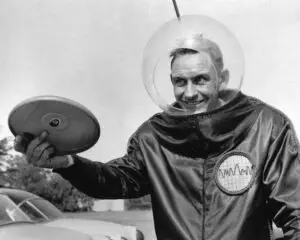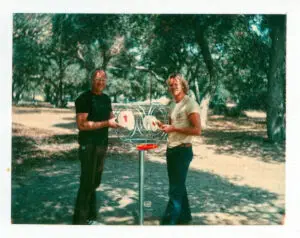Last updated on April 18th, 2024 at 09:05 am
Last updated by Turbo Ted

When you play a round of disc golf, you likely aren’t paying much attention to the equipment you are using. You may not know it but the disc you are throwing and the basket you are trying to hit are actually the end result of a lot of change that has taken place in the sport of disc golf. From its humble beginnings of people throwing a pie tin, to equipment that can handle the insane power today’s top pros, disc golf equipment has evolved to produce the amazing sport we know today. In this blog we want to look at the evolution of disc golf equipment and reflect on the people who contributed to making things better.
The Evolution of Disc Golf Equipment
Although mankind has been participating in disc sports for thousands of years, none of those activities (to the best of our knowledge) quite duplicated the play of modern disc golf. Given the materials used for their discs, it’s not surprising. Still, is goes to show you the fascination that our species has always had with flying things and competition.
In its modern iteration, flying disc competition started a little over a century ago. With no hard date for its beginning, we know that there were people throwing pie tins around for fun, due to their aerodynamic flight. There were several different pie-tin companies whose tins were used for recreational purposes, but historically the most popular of these was the Frisbie Pie Company.
Legend has it that Frisbie employees would throw pie tins around on break. This activity gravitated from the plant to the dorms in the area. College students picked up the new ‘sport’ and basically created a new need that some businessman was sure to fill. And an entrepreneur certainly did. However, that person was inspired by his own experiences with flying metal objects.
Beginnings Of Plastic Discs
Fred Morrison was an entrepreneur who discovered that he got a lot of entertainment throwing a popcorn can lid with his girlfriend. The part he didn’t like was when the lid would frequently get dented and not fly as well, and needed to be replaced. He soon discovered that cake pans flew better, and were easier to find. He also learned that other people were interested in throwing cake pans, and were willing to pay for them. Morrison found a little business success buying cake pans, then selling them for a profit. It wasn’t until after he returned from World War II that he took his little side hustle to the next level.

In 1946 Morrison sketched his idea for the world’s first flying disc. He called it the Whirlo-Way and started looking for a way to get in produced. Two years later, with the help of an investor, he went into production. He changed the name to the Flyin-Saucer. The disc was not an immediate hit, and he and his partner went their separate ways.
Despite its slow start, Morrison kept trying to sell the disc. He had been buying discs from the original manufacturer, but eventually learned he could make the discs himself for cheaper than the manufacturer he had been purchasing from. In 1955, he and his wife designed the now-famous Pluto Platter, which resembles the shape of modern-day Frisbees. A couple of years later in 1957, Morrison and his wife sold the rights to the Pluto Platter to Wham-O, who produced the disc under that name, but also included the name Frisbee.
Pluto To Wham-O
With the Pluto Platter being widely distributed, the popularity of throwing discs grew and grew. Then, along came a Wham-O employee by the name of Steady Ed Headrick and changed the direction of discs and disc sports.
Headrick’s job was to find new products to sell for Wham-o. He worked on various products, but at some point took another look at the Pluto Platter. He liked the disc, but came up with his own design and got it patented. That design is what most people are familiar with when they think of a modern-day Frisbee. In addition to inventing the design, Headrick came up with competitions using his Frisbees in order to promote them. Among the many events that grew out of the new design was an early version of disc golf.

As the sport of disc golf evolved and began setting formal rules for competition, so too was the need for discs that were specific for the sport. When Dave Dunipace designed and patented his disc design in 1983, called the Eagle, disc golf was transformed. Dunipace started Innova Champion Discs, and soon Innova and other companies were designing and manufacturing new molds to give disc golfers options for disc golfers around the world.
What Changed
As disc golf began to evolve, so did the need for discs to suit the needs and preferences of modern disc golfers. Wider rims meant faster speeds and the capability to handle more powerful throws. Beaded discs gave players options for putters that felt the best to them. A variety of plastics meant disc gofers could get the feel they were looking for. Thanks to the evolution of the disc, our sport has become what it is today!
The Disc Golf Basket

We don’t know exactly when first game of disc golf was played. I suspect it was shortly after the Pluto Platter was produced. Although it could have been in the ‘pie tin’ era. Regardless, we know that there were early attempts to play ‘target’ golf, where participants aimed for circles on the ground, including hula-hoops. Undoubtedly, object golf start either at the same time or shortly after. The goal with object golf is to hit whatever object was chosen as the objective. This version of disc golf was something that Ed Headrick was drawn to.
Shortly after Headrick designed the modern Frisbee disc, he began playing object golf. He would compete with friends and family members, picking targets as they played. Headrick began to see the potential of this new sport, and wanted to focus his time and energy to help it grow. Unfortunately, Wham-O didn’t share his vision.
It was in the mid-70’s that Steady Ed Headrick caught the disc golf bug and thought it would be a great fit for Wham-O. Had his employer wanted to be a part of this new sport, we would be calling it Frisbee Golf instead of disc golf. Since Wham-O didn’t want the name of their product associated with this new sport nor to be a part of its growth, Headrick decided it was time to part ways and pursue disc golf full time. Soon after, Disc Golf Association (DGA) was born.
The Mach Basket Is Born
Seeing a need for standard targets to throw at, Headrick started DGA and worked to design a basket that would give players more consistent finishes. Up to that point people had been using poles, nets, and other objects to catch discs. Headrick’s design used chains to slow the disc down, and a basket to catch the disc. He patented his design and began producing the Mach I basket. All of the baskets we have today are based on that simple design.

The Mach I was a step in the right direction, but Headrick knew he could improve the design. He continued to pioneer basket development and produced numerous improvements to his original design, along with patents for each improvement. The Mach I became the Mach II, Mach III, and Mach IV, and several versions since then. Each new basket correcting issues or improving results.
Other brands started producing baskets with their own flavor and ideas, up until today. We may not appreciate the progress baskets have made, particularly after a nasty chain out, but disc golf baskets have evolved and improved, much like the discs they are catching.
Reflecting On History
The next time you are out playing at your local course, take a minute to appreciate the people who contributed to the growth and changes to disc golf. We wouldn’t be where we are without the vision and hard work of the people who imagined where the sport could get to, then worked to make it happen.
